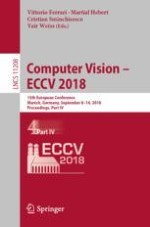2018 | Buch
Computer Vision – ECCV 2018
15th European Conference, Munich, Germany, September 8-14, 2018, Proceedings, Part IV
herausgegeben von: Vittorio Ferrari, Prof. Martial Hebert, Cristian Sminchisescu, Yair Weiss
Verlag: Springer International Publishing
Buchreihe : Lecture Notes in Computer Science
